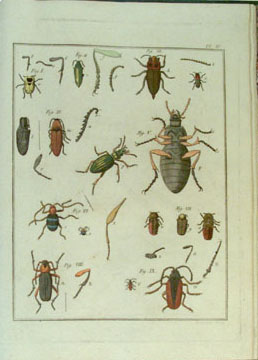Étienne Louis Geoffroy facts for kids
Étienne Louis Geoffroy (born October 12, 1725 – died August 12, 1810) was a smart French scientist who studied insects and also worked as a pharmacist. He was born in Paris, France, and passed away in Soissons. Geoffroy was very important because he followed a special way of naming living things, called binomial nomenclature, which was created by Carl von Linné. He spent most of his time studying beetles, which are a type of insect.
Contents
Who Was Étienne Louis Geoffroy?
Étienne Louis Geoffroy was a French expert in insects, known as an entomologist. He also had a job as a pharmacist, which means he prepared and sold medicines. He lived during a time when science was growing fast, and many new discoveries were being made about the natural world.
Geoffroy's Early Life and Education
Geoffroy was born in the big city of Paris in 1725. We don't know a lot about his early schooling, but it's clear he developed a strong interest in science, especially in living creatures. His work as a pharmacist likely gave him a good background in careful observation and classification, which are key skills for studying insects.
How Geoffroy Named Insects
One of the most important things Geoffroy did was use a system called binomial nomenclature. This is a fancy way of saying "two-name naming system." It means every animal and plant gets two names: a genus name and a species name. For example, humans are Homo sapiens. This system was invented by a famous Swedish scientist named Carl Linnaeus. Geoffroy helped make this system popular in France, especially for insects. This made it much easier for scientists all over the world to talk about the same creatures without getting confused.
Why Binomial Nomenclature Matters
Before this system, different scientists might call the same insect by many different long names. This made it hard to share information. With binomial nomenclature, every insect has a unique, short, two-part name. It's like giving every person a first and last name, making it easy to identify them. Geoffroy's use of this system helped bring order to the study of insects.
Geoffroy's Important Books
Geoffroy wrote some very important books about insects, especially those found around Paris. These books helped other scientists learn about and identify different types of insects.
Histoire abrégée des Insectes
His most famous book was called Histoire abrégée des Insectes qui se trouvent aux environs de Paris. This translates to "A Short History of Insects Found Around Paris." It was published in 1762. In this book, Geoffroy carefully described many different insects, especially beetles, that lived near his home city. He included detailed descriptions and even drawings to help people identify them. This book was a big step forward in understanding the insect life of France.
Entomologia Parisiensis
Later, in 1785, Geoffroy worked with another scientist named Antoine François on a book called Entomologia Parisiensis. This book was also about insects found in the Paris area. It was like an updated catalog of all the insects they had found. Working with other scientists was common, and it helped spread knowledge even faster.
Why These Books Were Important
These books were like early encyclopedias for insects. They helped scientists and nature lovers identify, classify, and learn more about the tiny creatures around them. Geoffroy's detailed work helped lay the groundwork for future entomologists.
Geoffroy's Legacy
Étienne Louis Geoffroy's work helped shape the study of insects in France and beyond. By adopting Linnaeus's naming system and publishing detailed books, he made it easier for everyone to understand the amazing world of insects. His focus on beetles showed how much variety there is even within one group of insects.


